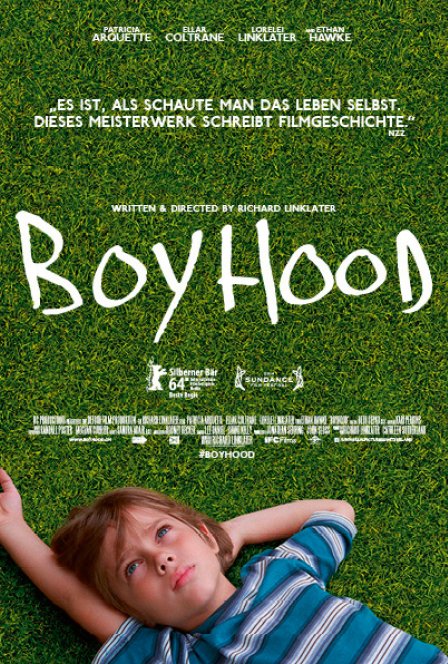“I want to write a novel that takes place in the span of a single pop song,” proclaimed Ethan Hawke’s writer protagonist in Before Sunset, one of many wistful sentiments in Richard Linklater’s blissfully self-absorbed 2004 film. By that point in time, the director was already two years deep into crafting Boyhood, a chronological portrait of a boy’s life from age 6 to 18 that begins with a moment considerably more saccharine, yet so sincere that it’s likely to throw off some viewers. Young Mason (Ellar Coltrane) lays on the grass looking at the daytime sky, as the soundtrack booms a familiar tune: “Look at the stars, look how they shine for you/ And all the things you do.” But nary a star is to be found. Nothing is yellow. Does it really matter? Behind every cultural object we consume lies a wealth of associations and judgments specific to each person — building the very image-repertoire of our lives. Whether the intent is commercial, political, or simply personal, a pop song is fated to be married with an image. It’s the ideal version of our lives, the schema by which all others will be judged. We live or die by the music.
“When a sound can replace an image, cut the image or neutralize it. The ear goes more towards the within, the eye towards the outer.”
– Robert Bresson
Boyhood isn’t pop cinema, but there’s a lot of pop music in it. All of it serves as the only clear indication of how much time has passed, other than the ebb of Coltrane’s pubescent glow. Ever since Before Sunrise (and, most radically, with his 2001 real-time DV feature Tape), Linklater has been known for building scenes moment-to-moment, allowing his characters to occupy a present weighed down by emotions built up over time, as expressed uniquely through his characters’ typically digressive and free-flowing conversations — all of which are strung together seamlessly in each cut. It’s an approach designed to elicit individual responses from each viewer, inviting us to compare our own half-formed ambitions with lives distinctly in transition. Yet Boyhood, which was shot on-the-fly from 2002 to 2014, is a rare film that allows us to view how it discovered itself, letting the passage of time, place, and world events to shape an individual narrative. It’s a sort of cinephilic documentary: in the same way that we take pleasure from watching old films, noting objects as signifiers of their cultural moment, here, they are offered to us directly as a mode of lived experience.
But within this conceptual framework are characters, of course, and a specific set of circumstances. Mason grows up in Austin, Texas with his sister (an enthralling turn by the director’s daughter, Lorelei Linklater), doted upon by his psychology professor mom (Patricia Arquette), with occasional visits from his quasi-bohemian dad (Ethan Hawke, who else?). As the family moves to a new house, Mason plays Oregon Trail, builds his arrowhead collection, and attends the opening night release of the sixth Harry Potter book. His dad reads Jon Krakauer, takes Mason camping (“How are the s’mores?” “Advertisement-quality”), and some years later, remarries into a family of gun-toting Christians. Mom is in grad school and shacks up with a white-haired professor with a weakness for booze; later, having taught her first psych course, she marries an Iraq War vet who preaches mutual respect. Nobody’s perfect; nobody makes good on their ambitions; their desperation is all but invisible. What’s a boy to do?
Much like Kenneth Lonergan’s ambitious film maudit Margaret, Linklater puts a naturalistic lens on a wide cast of characters whose worldviews don’t coexist easily, but who are nevertheless given a chance to reveal themselves. The cumulative effect of these individual narratives, which deepen over the course of the film, is one of great empathy and possibility. This prevents the film from being a simple case study, as it never resorts to overt psychology: for the first half of the film, Mason is almost a supporting character in his own life, noticing details and flawed logic in front of him, until he takes small steps to affirm his independence. (It’s no surprise that he eventually picks photography as an extracurricular in high school, potentially turning the very act of observation into a career). The journey of Mason’s selfhood is one of repeatedly learning how to deal with other people’s selfish behavior, much as the film never chooses one through-line for us — all childhood traumas, it would seem, are relative.
In his survey of the “teen movie” genre from the late 1970s to the 90s, Adrian Martin writes about the “form of pop knowingness in these films, a reflection of a generation’s knowledge of and passion for popular culture in all its forms… lived in and through references to pop culture, its images, catch phrases and emotional experiences.” He also deems the teen movie as “the least sacred and most secular” of genres. In spite of Linklater’s generous worldview and fidelity to lived experience, I wonder what Boyhood would have looked like had it shunned political correctness and let Mason indulge in all the boyish mischievousness we don’t see much of on screen — a teen Wolf of Wall Street perhaps? Yet Boyhood’s triumph is in its embrace of popular culture amid its accumulation of potential narratives for its innately incomplete protagonist, lost in endless thought and perception as much as he is visibly bound to the physical reality in front of him. Whatever path he ends up choosing, at least he was listening. Are you still listening?

